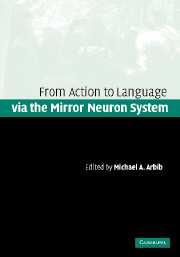Book contents
- Frontmatter
- Contents
- List of contributors
- Preface
- Part I Two perspectives
- Part II Brain, evolution, and comparative analysis
- 3 Cognition, imitation, and culture in the great apes
- 4 The signer as an embodied mirror neuron system: neural mechanisms underlying sign language and action
- 5 Neural homologies and the grounding of neurolinguistics
- Part III Dynamic systems in action and language
- Part IV From mirror system to syntax and Theory of Mind
- Part V Development of action and language
- Index
- References
5 - Neural homologies and the grounding of neurolinguistics
Published online by Cambridge University Press: 01 September 2009
- Frontmatter
- Contents
- List of contributors
- Preface
- Part I Two perspectives
- Part II Brain, evolution, and comparative analysis
- 3 Cognition, imitation, and culture in the great apes
- 4 The signer as an embodied mirror neuron system: neural mechanisms underlying sign language and action
- 5 Neural homologies and the grounding of neurolinguistics
- Part III Dynamic systems in action and language
- Part IV From mirror system to syntax and Theory of Mind
- Part V Development of action and language
- Index
- References
Summary
Introduction
Homologies and language evolution
We are interested here in homologous brain structures in the human and the macaque, those which may be characterized as descended from the same structure of the brain of the common ancestor. However, quite different paths of evolution, responsive to the need of different organisms for similar functions, may yield organs with similar functions yet divergent evolutionary histories – these are called homoplasic, rather than homologous. Arbib and Bota (2003) forward the view that homology is not usefully treated as an all-or-none concept except at the grossest level, such as identifying visual cortex across mammalian species. Even if genetic analysis were to establish that two brain regions were homologous in that they were related to a common ancestral form it would still be important to have access to a measure of similarity to constrain too facile an assumption that homology guarantees similarity across all criteria.
Indeed, from the perspective of computational and comparative neuroscience, declared homologies may be the start, rather than the end, of our search for similarities that will guide our understanding of brain mechanisms across diverse species. When two species have diverged significantly from their common ancestors, a single organ x in ancestor A might differentiate into two organs y and y′ in modern species B and three organs z, z′, and z″ in modern species C. For example, a region involved in hand movements in monkey might be homologous to regions involved in both hand movements and speech in humans.
- Type
- Chapter
- Information
- Action to Language via the Mirror Neuron System , pp. 136 - 174Publisher: Cambridge University PressPrint publication year: 2006
References
- 6
- Cited by



